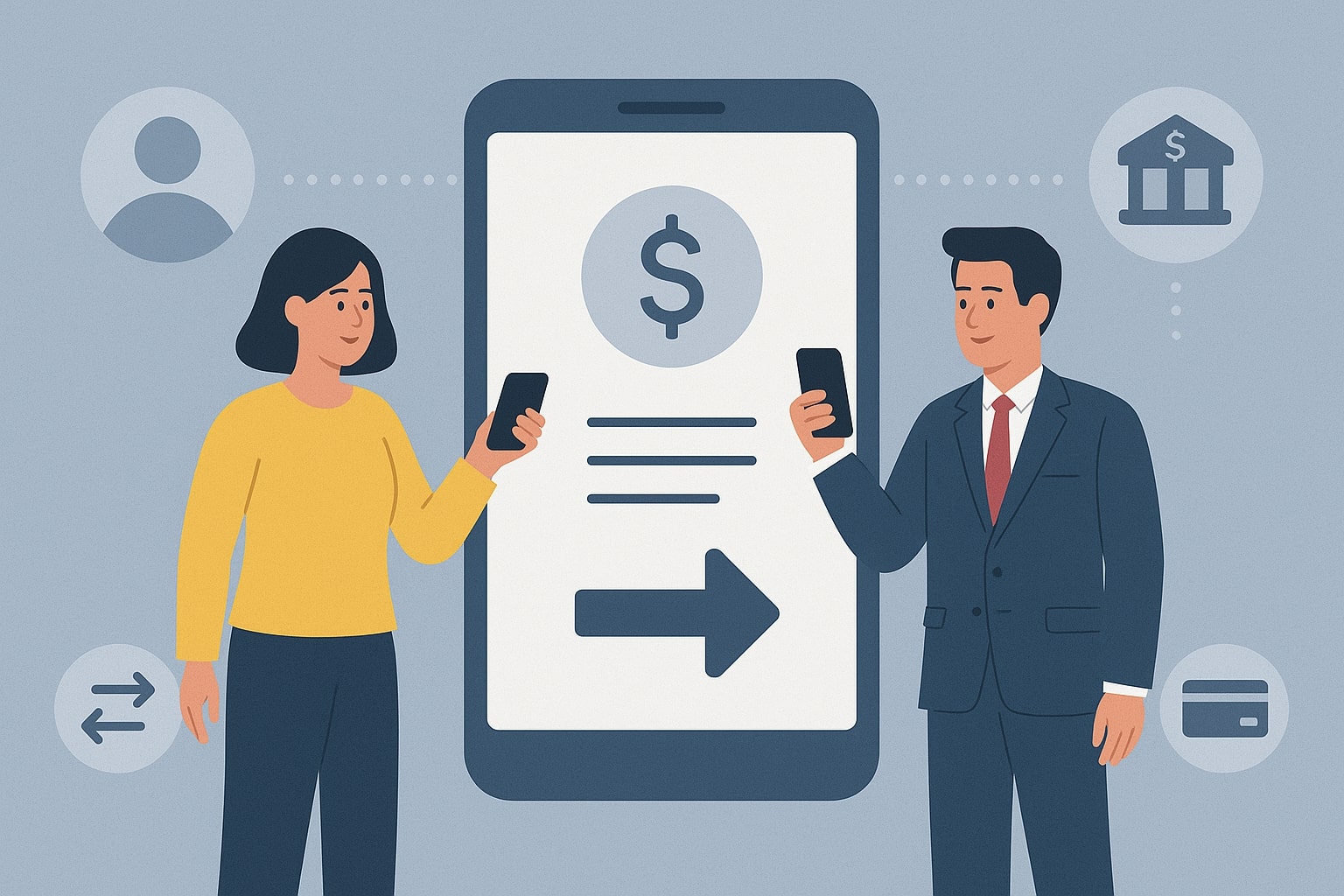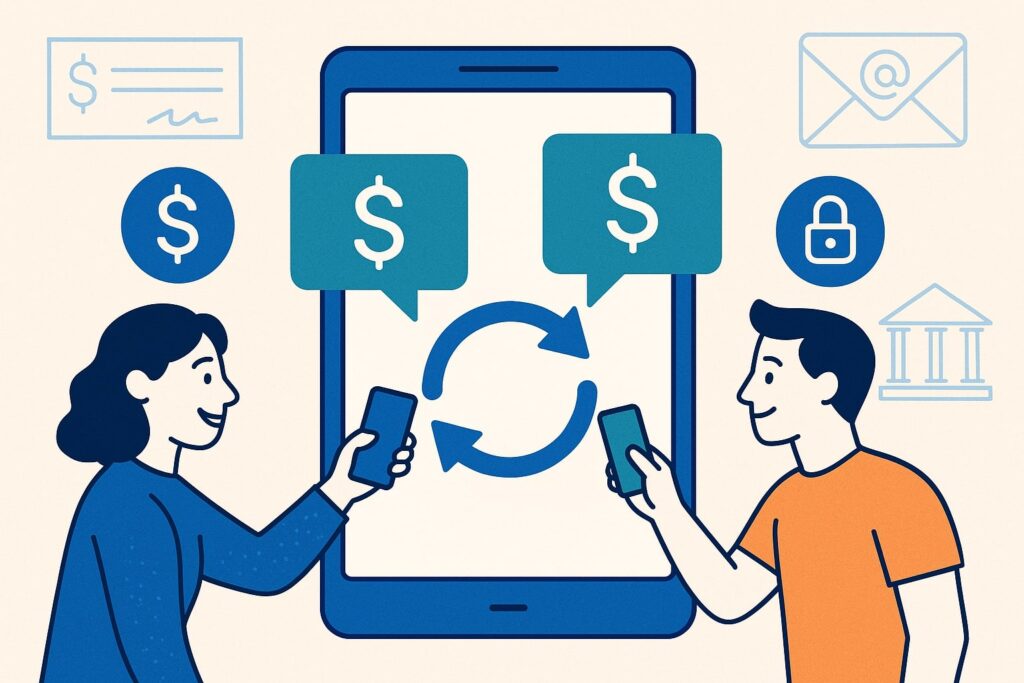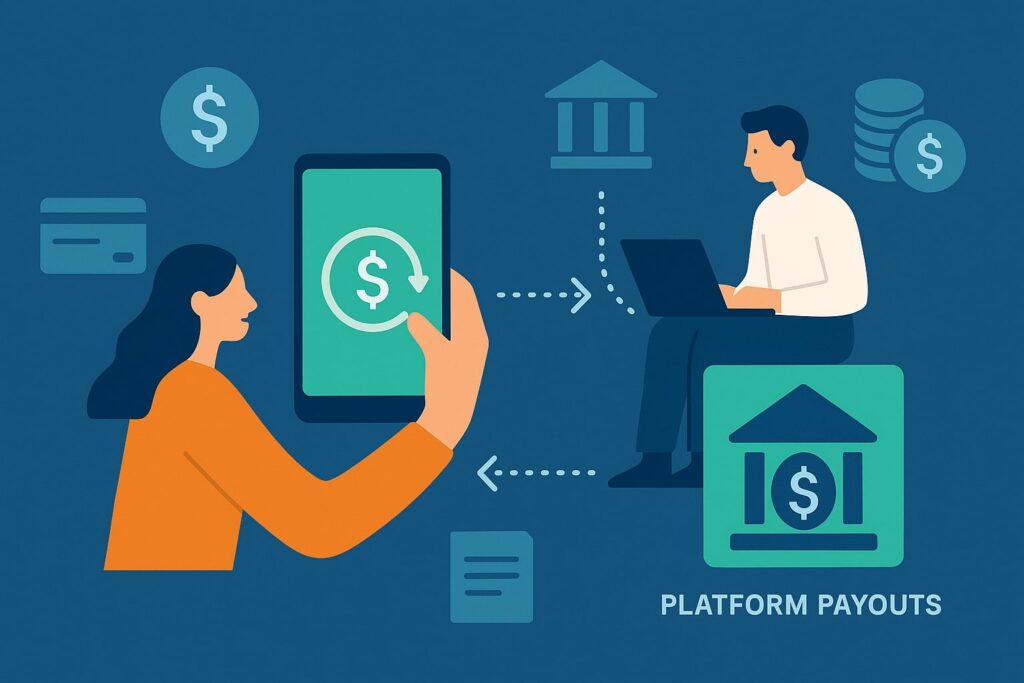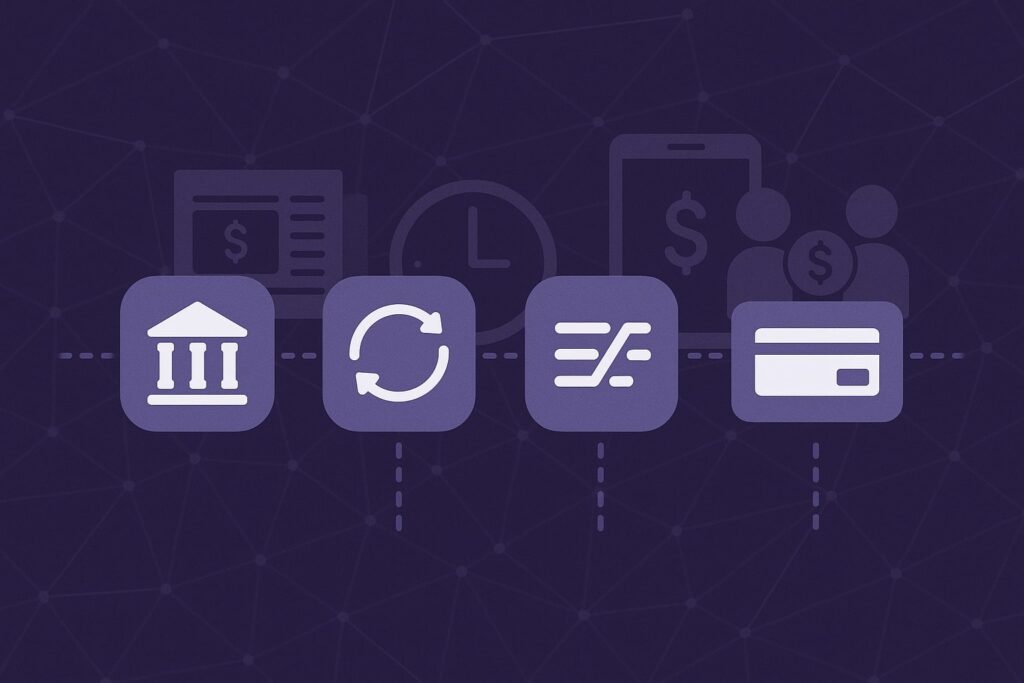
By p2pbusinesspayments October 26, 2025
P2P payments—short for peer-to-peer payments—have transformed how money moves in the United States. What began as a convenient way for friends to split a dinner check has evolved into a powerful set of rails and experiences that now serve freelancers, micro-businesses, platforms, and even large enterprises.
Today, P2P payments power instant disbursements, marketplace payouts, biller collections, and just-in-time supplier payments. As real-time networks mature and regulations adapt, P2P payments are converging with “P2B” and “B2P” flows, enabling faster cash flow and lower operating friction across the economy.
This article traces the technological, regulatory, and commercial journey of P2P payments in the U.S., explains how businesses can safely adopt P2P payments, and maps the road ahead with FedNow®, RTP®, ACH, card push-to-card, and emerging rules shaping compliance and reporting.
We’ll keep the guidance current with 2025 updates that matter to U.S. businesses, and we’ll make the language easy to scan so decision-makers can put P2P payments to work immediately.
What P2P Payments Are—and Why They Matter in 2025

P2P payments are digital transfers of funds between individuals through mobile apps or online services. In the U.S., P2P payments started with consumer-first apps that emphasized instant notifications, contact-based addressing, and a social-style experience.
That consumer UX—combined with always-on availability—set expectations for speed and simplicity that have spilled over into business use. Small merchants now want to get paid as fast as they message; contractors want to be paid as quickly as a text; and marketplaces want to pay sellers with minimal friction.
P2P payments matter in 2025 because they compress the time between work and pay. They also lower the need for cash handling or paper checks, reduce manual reconciliation, and improve customer satisfaction with instant confirmations.
For the U.S. region, where card networks, ACH, and bank-to-bank systems have coexisted for decades, modern P2P payments serve as a unifying experience atop multiple rails.
The result is choice: ACH for cost and reach, RTP and FedNow for real-time clearing, and push-to-card for ubiquity across debit cards. Businesses that learn to route P2P payments to the right rail gain speed, control, and savings.
Common P2P Payment Terms You’ll See
Understanding the vocabulary behind P2P payments helps teams evaluate vendors and design resilient cash-flow processes. “Instant payments” means funds clear and post within seconds, 24x7x365, with finality—think RTP® from The Clearing House and FedNow® from the Federal Reserve.
“Faster payments” is broader and can include same-day ACH or push-to-card, which are quick but not always instant. “Push-to-card” (Visa Direct, Mastercard Send) sends funds to eligible debit card accounts, typically reaching recipients fast with broad consumer coverage.
“Directory” refers to how users find each other—phone numbers, emails, or bank aliases. “Credit transfer” is a payer-initiated push; “debit pull” is a payee-initiated request. “Request for Payment” (RfP) lets a biller or business send an invoice that customers pay directly through a real-time rail.
“Settlement” is the movement of money between institutions; “posting” is when funds become available in the recipient’s account. “TPSO” (Third-Party Settlement Organization) is an IRS term relevant to platforms that facilitate payments between buyers and sellers, and it matters for 1099-K reporting thresholds that are changing between 2024 and 2026.
From “Pay Your Friend” to Platform Payouts: A Short History

Early U.S. P2P payments focused on consumers: split bills, roommate rent, shared rides. Network effects and a mobile-first design created habits. As volumes grew, platforms realized the same experience could modernize marketplace payouts, gig-worker disbursements, and customer refunds.
The rise of on-demand work accelerated the shift. Workers wanted funds instantly after each job, and platforms wanted to reduce support tickets tied to “Where’s my money?” That pressure pushed P2P payments closer to true real-time rails.
In parallel, ACH modernized with same-day windows, while card schemes scaled push-to-card capabilities. The Clearing House’s RTP launched in 2017 as the first U.S. real-time clearing and settlement network.
The Federal Reserve launched FedNow in 2023, adding a second real-time rail and catalyzing adoption across diverse financial institutions. As of 2025, both real-time networks are expanding, with more banks offering instant services to consumers and businesses.
The era of “P2P is only for friends” is over; P2P payments have become a mainstream way to move business funds with speed and certainty.
The 2025 Inflection: Limits, Participation, and Use Cases
Two 2025 milestones accelerated business adoption. First, The Clearing House raised the RTP® transaction limit to $10 million, which unlocked high-value use cases like corporate disbursements, treasury movements, and large B2B supplier payments—well beyond classic consumer P2P transactions.
Published industry data and TCH commentary describe how the higher cap drove a surge in total value over the network in mid-2025. Second, the Fed began publishing quarterly FedNow® volume and value statistics, showing rapidly growing usage across participating institutions.
For CFOs and product teams, these shifts mean P2P-style, real-time experiences can now cover everything from $20 reimbursements to multi-million-dollar B2B payments with finality and rich messaging.
The market is moving from “nice-to-have” instant payouts to “must-have” instant cash flow that reduces working capital gaps and improves vendor relationships.
The Rails Behind P2P Payments: ACH, RTP, FedNow, and Push-to-Card

To choose the right P2P payments strategy, U.S. businesses must understand the rails under the hood. ACH offers unmatched reach and low cost, with same-day options for time-sensitive transfers. ACH is dependable for payroll, vendor payments, and recurring debits; however, settlement is batch-based and not always instant.
RTP®, operated by The Clearing House, is an instant network that clears and settles in seconds, with 24x7x365 availability and messaging (including Request for Payment).
FedNow®, operated by the Federal Reserve, provides comparable instant clearing and is adding participants quarter by quarter, with official quarterly statistics publicly posted by Federal Reserve Financial Services.
Push-to-card options like Visa Direct and Mastercard Send ride the card networks and can reach recipients via eligible debit cards within minutes, especially effective for B2C payouts and refunds.
The smart move is to support multiple rails and route payments based on ticket size, recipient preference, cost, and urgency. For instance, use push-to-card for customer refunds, RTP or FedNow for on-demand earnings, and ACH for scheduled vendor invoices.
Real-Time Momentum: What the Latest Numbers Signal
Fresh data points reinforce the real-time trend. In Q2 and Q3 of 2025, FedNow® reported strong quarter-over-quarter growth in settled payments and values, indicating expanding adoption and higher average transaction sizes.
At the same time, The Clearing House highlighted how raising RTP’s per-payment cap to $10 million more than tripled payment value on the network, a sign that enterprises are moving larger transactions to real-time rails.
For product leaders, these are green lights to invest in real-time P2P payment options, embed Request for Payment in billing flows, and negotiate bank connections that support both RTP and FedNow.
For treasury teams, the data justifies revisiting cash-positioning practices, liquidity buffers, and intraday credit lines, because money is now actually moving—and settling—at all hours.
Regulation, Risk, and Reporting: What U.S. Businesses Must Know
Compliance defines how P2P payments scale safely. In the U.S., three topics stand out in 2025: consumer protections and fraud response for bank-owned P2P apps, platform reporting via Form 1099-K, and controls for instant payments.
The Consumer Financial Protection Bureau (CFPB) has scrutinized Zelle and its owner banks regarding fraud remediation and consumer harm. While the Bureau brought high-profile litigation in late 2024 and early 2025, it later dismissed the lawsuit in March 2025.
The enforcement backdrop still matters for how banks and platforms handle scam claims, disclosures, and risk screening.
On reporting, the IRS adopted a staged transition for 1099-K thresholds: more than $5,000 in 2024, more than $2,500 in 2025, and $600 in 2026 and beyond, impacting third-party settlement organizations (TPSOs) and sellers who receive payments for goods or services.
Finally, instant rails require enhanced controls: recipient validation, behavioral analytics, velocity limits, and out-of-hours monitoring. Businesses embracing P2P payments should coordinate with banking partners to align fraud policies with user expectations and regulator guidance.
Fraud Trends and Practical Controls for P2P Payments
Social-engineering scams and account-takeover attacks continue to target instant experiences because irrevocable payments are hard to claw back. Large banks have begun tightening flows that appear tied to social media or marketplace scams, reflecting a broader push to reduce risky transactions.
Practical controls for businesses include pre-funding checks, device fingerprinting, name-match and sanctions screening, multi-factor authentication on high-risk actions, and progressive limits that rise with good history.
Real-time “Request for Payment” reduces fat-finger errors by letting payers confirm details before funds leave the account. Transparent user education also matters: tell customers how P2P payments behave, what protections apply, and when to pause and verify.
A layered model—education, authentication, analytics, and after-care—lets you use P2P payments without accepting unnecessary loss.
How P2P Payments Enter the Business Stack
Bringing P2P payments into a business is both a product and operations decision. Start by mapping use cases: instant disbursements to workers, seller payouts, refunds, claim settlements, or collections via request-to-pay.
Each use case has different risk, cost, speed, and messaging requirements. Next, select rails based on those requirements, and confirm bank or processor support.
Many businesses use a gateway or payment partner to orchestrate across ACH, RTP, FedNow, and push-to-card, exposing one API to product teams. Finance teams should work with the partner on reconciliation feeds and robust webhooks for status changes.
Instant posting introduces new reconciliation patterns; your ledger should capture unique payment IDs, timestamps, and return codes. Finally, design the recipient experience—how users enroll, verify accounts, and receive funds. Good UX reduces support tickets and increases adoption.
Integrations that Make P2P Payments Operational
Strong integrations are the difference between a flashy demo and sustainable P2P payments. Connect your payouts system with accounting (QuickBooks, NetSuite) to auto-post entries.
Feed status changes and exceptions to a case management tool so support can resolve issues quickly. If you use a marketplace model, link P2P outputs to a tax engine to track 1099-K exposure and seller thresholds as rules evolve from 2024 to 2026.
Add compliance checks, such as OFAC screening and anomaly detection, to the payment orchestration layer rather than each product team reinventing controls.
Build dashboards for treasury that show real-time positions across banks and rails, including RTP and FedNow cutover behaviors. Finally, rehearse incident runbooks for fraud events on instant rails; seconds matter, and pre-approved actions can contain losses before they spread.
Costs, Timing, and Routing: Picking the Right Rail for Each Job
Cost and speed tradeoffs define P2P payment routing. ACH is inexpensive and ubiquitous but not instant, though same-day windows help. RTP and FedNow are instant with per-payment caps and bank participation variability.
Push-to-card reaches a vast number of debit cards in minutes, often with per-transfer fees that are higher than ACH but lower than many manual alternatives. The art is to route by context. Low-value, non-urgent payouts can ride ACH.
Urgent seller disbursements or employee earnings can ride RTP or FedNow for instant availability. Customer refunds can use push-to-card for broad reach and “delight.” Add policy rules like: “Use FedNow or RTP for invoices under $100k due today; fall back to ACH if the counterparty is not reachable on instant rails.”
Monitoring rail availability and bank participation is essential; FedNow publishes quarterly stats, and your bank or processor can confirm RTP reachability and the new $10 million cap’s impact on your use case portfolio.
Measuring the ROI of P2P Payments in a Business
To prove ROI, track downstream effects, not just payment fees. Measure reduced days sales outstanding (DSO), lower support contacts about “missing checks,” fewer charge disputes from unclear timing, and higher seller retention due to faster cash access.
For on-demand labor, measure shift acceptance and churn after enabling instant payouts. For marketplaces, track listing growth and GMV after faster seller settlements. The Treasury should quantify the value of 24×7 liquidity options against intraday credit costs.
Compliance can measure incident rates and time-to-resolution before and after adding controls like biometric authentication, RfP billing, and name-match. When leaders see the full picture—revenue lift, operating savings, and risk reduction—P2P payments shift from a “cost center” to a growth and loyalty engine supported by real-time rails.
Tax, Accounting, and Reporting Considerations
In 2025, platform and marketplace operators must watch Form 1099-K rules closely. The IRS has set a phased transition: more than $5,000 in total payments for goods or services triggers reporting in calendar year 2024, more than $2,500 in 2025, and $600 in 2026 and after.
This matters if you operate as a Third-Party Settlement Organization (TPSO) facilitating P2P payments between buyers and sellers. Align your onboarding flow to collect necessary tax details early, including TIN and legal name, and keep a watchlist of sellers approaching thresholds.
Your accounting system should tag P2P transactions with intent (goods/services vs. personal) to reduce misclassification risk. Finally, revisit backup withholding procedures and ensure vendors receive accurate, timely statements.
Clear education helps sellers understand why some P2P payments generate tax forms while pure personal transfers do not. Keeping records clean lowers audit risk and support load each January. Always consult a qualified tax advisor for your specific facts.
Reconciling Instant Money Movement
Instant posting changes how books close. Because RTP and FedNow settle within seconds, funds can arrive around the clock, including weekends and holidays. Design reconciliation that operates daily, not just at month-end.
Leverage unique transaction identifiers and ISO 20022-style data fields where available to link payments to orders, invoices, or jobs. Automate exception handling when a destination account is unreachable on an instant rail and you must fall back to ACH. Keep an audit trail for each reroute decision.
For refunds and chargebacks, understand that P2P credit transfers don’t behave like card chargebacks; refund workflows should be explicit rather than relying on dispute reversal.
Finally, plan for liquidity management—real-time payouts may require prefunding or intraday credit. Treasury policies should outline how to rebalance positions across banks when volumes spike after hours, using RTP and FedNow data feeds and alerts as signals.
Use Cases: Where P2P Payments Shine for U.S. Businesses
- On-demand worker payouts: From delivery couriers to field technicians, P2P payments let workers receive earnings instantly after completing a job. That improves worker satisfaction and retention, and reduces cash advance requests. Push-to-card and real-time rails are the usual choices here.
- Marketplace seller settlements: Marketplaces use P2P payments to settle sales proceeds daily or even per transaction. With RTP/FedNow, funds land in seconds; with push-to-card, sellers get near-instant access using existing debit cards. That speed boosts listing activity and loyalty.
- Insurance and claims: Insurers use P2P payments for instant claim disbursements so policyholders can begin repairs or replacement quickly. Real-time rails provide certainty and strong messaging for claim IDs.
- Refunds and customer goodwill: Retailers and service providers deliver quick refunds via push-to-card, which customers perceive as fair and modern.
- Biller collections with RfP: Utilities and telcos send real-time “Requests for Payment” so customers can approve from within their mobile banking apps, reducing late payments and improving cash flow.
Industry Examples and Choosing the Right Mix
Home services platforms often combine ACH for predictable weekly payouts with push-to-card for instant options workers can choose for a small fee. E-commerce marketplaces adopt RTP or FedNow for larger sellers while keeping push-to-card for long-tail sellers.
Healthcare reimbursements may prefer ACH for cost unless a patient needs funds immediately. Auto dealers can use instant rails for high-value dealer-to-finance settlements now that RTP supports up to $10 million per payment, while keeping ACH for routine vendor bills.
In each case, start with user needs, then layer in rail availability, reachability, cost, and risk. Pilot with a narrow population, measure NPS and support contacts, and scale where the value is clear.
Security, Trust, and Customer Education
P2P payments thrive when users trust the experience. That trust begins with precise disclosures: explain which protections apply to which flows, and clarify that “instant” also means “final.” Offer safeguards such as payee name-match, payment previews, and clear cancellation rules before funds move.
Provide in-app education about classic scam patterns: urgent requests, impersonation, or requests to move off trusted channels. Banks have tightened policies around high-risk social media-originated Zelle transfers; adopt a similar posture for your P2P flows by detecting risky contexts and slowing them down.
Make reporting frictionless—one tap to flag suspicious activity—and provide status updates as you investigate. Swift, empathetic responses to victims help sustain confidence without promising blanket refunds where protections don’t apply.
Finally, keep a feedback loop with your banking partners; they’ll share emerging typologies that your models should learn from.
Governance: Policy, Monitoring, and Audits
Treat P2P payments as a governed product. Maintain a written policy that defines permissible use cases, rail selection logic, limits, and escalation steps.
Monitor key risk indicators daily—fraud loss rate, scam complaints per 10,000 payments, average dispute resolution time, and instant-to-ACH fallback rate. Run quarterly access reviews for who can change limits or approve exceptions.
Conduct post-incident reviews and update runbooks. Audit your Request for Payment flows to ensure invoices, amounts, and references match ledger entries, and that customers can view a clear payment timeline. Governance is not bureaucracy; it’s how you protect speed and keep P2P payments sustainable at scale.
Roadmap: What’s Next for P2P Payments in the U.S.
Expect three themes to shape the next phase. First, deeper real-time adoption as more financial institutions join FedNow and more corporates take advantage of RTP’s higher limits for treasury-grade use cases.
Second, interoperability workarounds through processors that can “translate” reachability and message formats across rails, making the user experience feel seamless even if the rails are not interoperable.
Third, regulatory clarity around platform fraud responsibilities and tax reporting as the IRS transition continues through 2026. On the merchant side, we’ll see wider use of real-time Request for Payment in billing, rising use of instant payroll for hourly staff, and expanded “instant payouts” buttons across marketplaces.
For consumers, P2P payments will feel even more invisible—embedded in apps where the payment UX is a natural part of messaging, scheduling, or ordering.
The winners will be teams that design for speed without trading off safety, that route intelligently, and that make P2P payments a trustworthy part of everyday business.
2025 Updates Leaders Should Bookmark
Bookmark three official sources. First, the Federal Reserve’s FedNow® quarterly statistics page for the most current usage and value figures. Second, The Clearing House updates for RTP® rules, limits, and reachability.
Third, IRS 1099-K FAQs and bulletins for threshold timing between 2024 and 2026. These sources will keep your strategy grounded in facts, not headlines, and help you justify investment to executives and auditors alike.
When a use case grows, confirm that your bank supports necessary message types (like RfP) and that your processor can fail over to alternate rails cleanly.
Keep an eye on consumer-protection news from the CFPB as policies and industry practices evolve. With disciplined monitoring, your P2P payments program will remain compliant, cost-effective, and resilient.
FAQs
Q.1: Are P2P payments the same as instant payments?
Answer: Not exactly. P2P payments describe the user experience and use case, while instant payments describe the rail behavior.
Some P2P payments use instant rails like RTP® and FedNow®; others use push-to-card or same-day ACH. Choose rails based on speed, cost, reach, and recipient preferences. FedNow and RTP are true 24x7x365 instant rails with finality.
Q.2: What are the latest IRS Form 1099-K thresholds I should plan for?
Answer: The IRS adopted a staged approach: more than $5,000 in 2024, more than $2,500 in 2025, and $600 in 2026 and after. If you operate a platform that qualifies as a TPSO, ensure you collect tax details and monitor cumulative payment totals. Educate sellers proactively to limit confusion each January.
Q.3: How big can a real-time payment be on RTP®?
Answer: As of 2025, the maximum transaction limit on RTP® is $10 million, which has driven a sharp increase in payment values and opened larger B2B and treasury use cases. Your bank may set lower limits based on risk policies, so confirm program caps before launch.
Q.4: Is FedNow® widely adopted yet?
Answer: Adoption is growing. The Federal Reserve publishes quarterly FedNow® statistics showing rising volumes, values, and average ticket sizes, signaling growing participation by banks and credit unions. Check the latest figures to inform your business case.
Q.5: What about fraud protections for P2P apps like Zelle?
Answer: Regulators and banks have focused heavily on fraud and scam claims. The CFPB filed and later dismissed litigation in 2025 related to Zelle and several owner banks, but scrutiny remains high.
Some banks have added controls for higher-risk contexts, like social media-originated transfers. For your program, implement layered controls, clear disclosures, and fast support.
Q.6: How do I decide which rail to use for a given payout or collection?
Answer: Start with the business need. If timing is critical and the counterparty is reachable, use RTP or FedNow. If you need broad consumer reach with minimal onboarding, push-to-card is attractive.
If cost is king and timing is flexible, ACH fits. Many programs blend rails and let rules decide dynamically based on amount, risk, and recipient profile.
Q.7: Can I request money in real time, not just send it?
Answer: Yes. Request for Payment (RfP) messages are supported on RTP and available through participating banks. They let you present an invoice and receive an instant, data-rich credit transfer.
Adoption depends on bank support and your processor’s capabilities, but it’s a powerful tool for billers and merchants. (Confirm RfP support with your bank.)
Q.8: What internal teams should own P2P payments?
Answer: It’s cross-functional. Product owns customer experience. Payments/engineering own rail orchestration and reliability. Risk/compliance own controls. The Treasury owns liquidity and bank relationships.
Finance and tax manage reporting and 1099-K. Align KPIs so teams share outcomes like reduced DSO, higher NPS, and controlled fraud losses.
Conclusion
P2P payments began as a simple way for people to pay each other. In 2025, they’ve matured into a set of instant and near-instant options that help U.S. businesses move money at the speed of work.
Real-time rails like RTP® and FedNow® continue to expand. Limits have increased, volumes are climbing, and the experience has grown up—supporting robust messaging, invoices, and treasury-grade transfers.
At the same time, rules around reporting and consumer protection are evolving, and leaders must keep programs compliant and users safe. The winning blueprint is clear: map use cases, choose rails intelligently, integrate deeply with accounting and risk systems, and educate users on how P2P payments behave.
With that foundation, P2P payments can reduce operating friction, accelerate cash flow, and create a competitive edge that customers, sellers, and workers will feel—every day, in real time.